Biblical Hebrew words can have multiple meanings and nuances. Each shade of color adds to the full picture.
 Multiple meanings for practically every single Biblical Hebrew word is the first key to get your head around. This is something impossible to see in your native language. Red is ONE word, but it comes in umpteen shades. Likewise, a Biblical Hebrew word can, and generally does, have various nuances, multiple meanings.
Multiple meanings for practically every single Biblical Hebrew word is the first key to get your head around. This is something impossible to see in your native language. Red is ONE word, but it comes in umpteen shades. Likewise, a Biblical Hebrew word can, and generally does, have various nuances, multiple meanings.
(Bible Course Unlock Bible Meaning with the 7 Keys to Master Biblical Hebrew, Key 1)
Straight away we see the limits of Bible translations. They are very helpful, but they are incomplete for one excellent reason.
The original words of the Bible, mainly in Hebrew and Greek, have more meaning than what we can render in any word-for-word translation. It is red, but what shade of red?
How can I affirm this? Take any translation, let’s say in Hebrew, you’ll see that a SINGLE original word translates into MULTIPLE foreign language words.
If word-for-word translation were so simple, every single Hebrew word would have only ONE and always the SAME translated counterpart. In the Old Testament of the Bible, there are about 8700 unique Hebrew words. In theory, we should be able to translate them with 8700 words in another language. Well, not only can you not do that, but it is impossible to do that.
We do have such mechanical or simple translations but, even there, they have appendices to expand on these single words. The fact is, each word has more than one simple meaning. Some Biblical Hebrew words have fifty different translations. Yes, you read that correctly, fifty different renderings as we’ll see. That’s multiple meanings.
You need to ask the fundamental question:
How can ONE Hebrew word have FIFTY varying translations? And beyond that, the much deeper question, why does ONE word have multiple meanings? We’re not just talking about words, these words signify actions, emotions, descriptions, feelings. They represent real-life reality. Biblically, they include everything spiritual, all the way to eternal life.
This is a serious matter. We’ve got to get it right and not let misunderstandings around words get in our way.
Before we answer that question, we need to clarify a point regarding translations. In the last post, I quoted my Biblical Hebrew professor, “All translations are interpretations.” This statement is correct, but does that mean we have to call into question either the scholarship or the sincerity of these translators? Absolutely not, on both accounts. The King James translation, as with most versions, is the work of accomplished language and Bible scholars. With each translated word, they are doing their utmost to stay faithful to their understanding of the meaning of the original text. In no way, am I contesting their erudition or their probity. In fact, the multiple translations testify to their comprehension that single Biblical Hebrew words have multiple meanings.
That said, the answer to that question “how can ONE Hebrew word have FIFTY varying translations?” is the reason I wrote this course, Unlock Bible Meaning with 7 Keys to Master Biblical Hebrew.
This course is just a concise answer to the above fundamental question. It really is a preview to The Explanation book series, where you’ll discover myriad examples of these seven unspoken, even unrecognized, characteristics of Biblical Hebrew. The Explanation will expand this course to include many more examples related to each of the 7 Keys.
You may not be aware of some examples I evoke here. All the more reason to read this document and increase your general knowledge. A friend of mine told me recently that he was playing a quiz game with some of his buddies. A Bible-related question came up, and he answered it, to the surprise of everyone there! He told me he knew the answer because of a conversation we’d had. You never know when this information will come in handy. Not that that’s your chief motivation.
I’ll even say that most people with some knowledge and interest in the Bible are not aware of these seven keys and definitely not of this study method to unlock Bible meaning. Not convinced? Ask a spiritual individual if they know that a single Hebrew word can have up to 50 translations. Ask them if they know why and especially what the implication of this has for Bible understanding.
I designed this course as a workbook filled with authentic examples that you can look up and study online as we progress. You need not do the practical exercises, but you will appropriate this Bible study method and learn faster if you do.
The goal of this course is not just to teach you the 7 Keys, but to help you be proficient in their use. You need them for your lifetime Bible study. When a Bible passage is unclear to you, you need a method to verify its meaning. Studying the multiple meanings of the original word can help you solve seeming discrepancies. It’s not the only method, but it will help.
Let’s dive into the first key, One Biblical Hebrew word can have multiple meanings. And, immediately, you can use the Bible study tools that are available to see this for yourself.
Davar = 50 translations in English
The first example of multiple translations for one Biblical Hebrew word is davar. You’ll find it in Exodus 34:28. Go over to https://UnlockBibleMeaning.com and search for ten commandments.
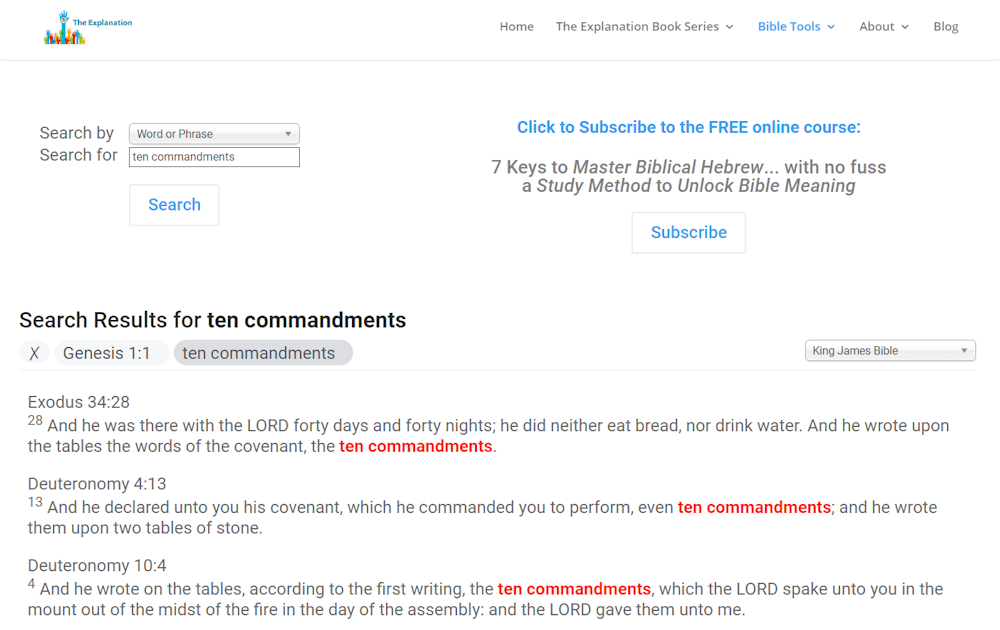
Ten Commandments. Search at UnlockBibleMeaning.com
- Switch the display from the King James Bible to the Strong’s Concordance view.
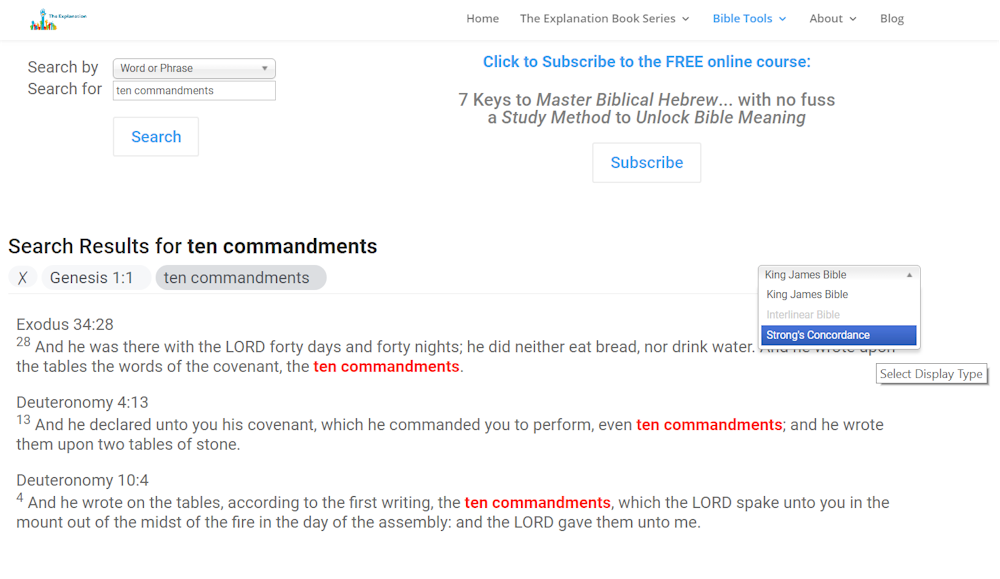
Ten Commandments. Switch to Strong’s Concordance.
- Click on the Strong’s number (H1697) to the right of commandments to see Strong’s information in the right column.
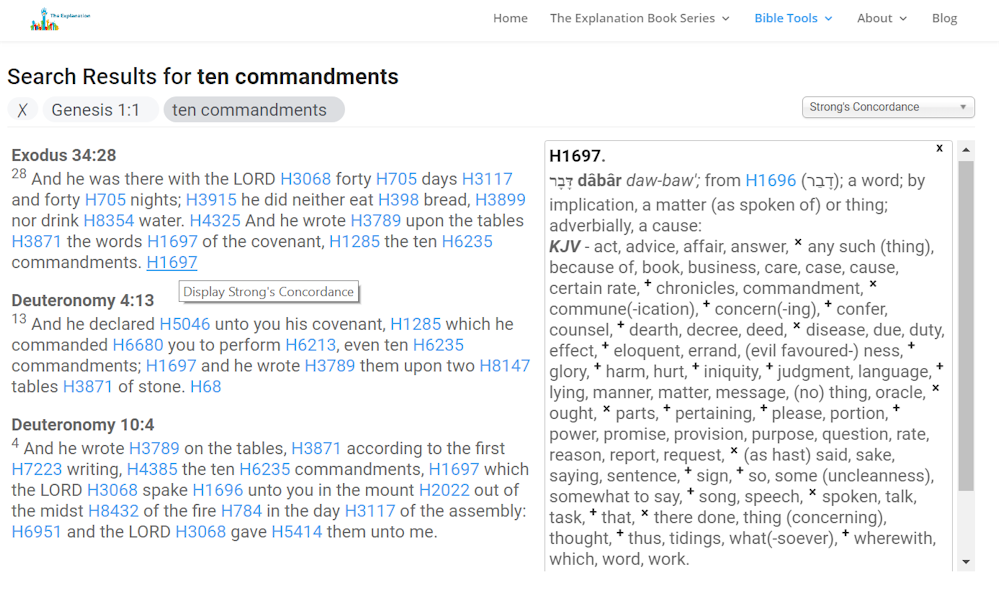
Ten Commandments. Click on H1697.
Frequently, throughout this book, we will look at this presentation of Biblical Hebrew words. On the right side of the screen the first paragraph, after the H1697 you’ll always find a commentary by Strong. We will refer to this often. This is a resume of the Biblical Hebrew word and its usage in scripture. I shall explain its value and relevance in more detail later.
Here you can see dabar summarized by word, a matter or a thing and cause.
Following the KJV (King James Version of the Bible), after Strong’s commentary, we see all the translations of this one word, used by the translators. For dabar, you can count about 50 translations. Notice the variety of translated words. We shall discuss this extensively.
There are words preceded by an x and a +. These words are additional translations in the Revised Standard Version, and the American Revised Standard Version. We will not refer to these translations, although they can add a note of modernity to the 1611 A.D. original work.
Below each Strong’s entry notice << Prev(ious) 5 | Next 5 >>.
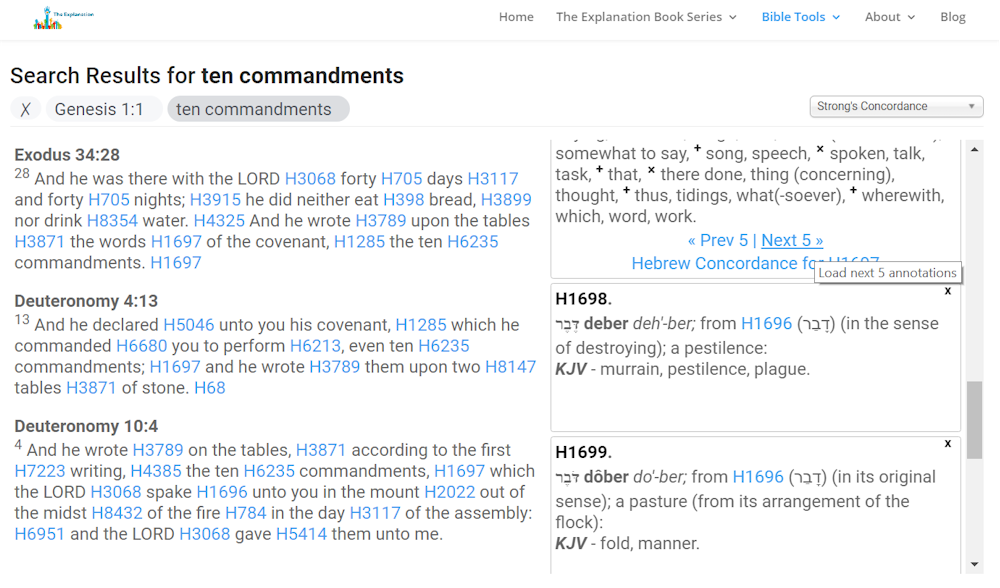
Ten Commandments. Click on Next 5.
By clicking on Next 5 you’ll display the next five Strong’s entries. For the time being, just notice that basically every single Biblical Hebrew word has at least a couple and often many more translations into English. Verify this first key regarding multiple meanings by clicking on these previous and next links. Check words before and after H1697. Most words have multiple translations. Understanding this is the first key to mastering Biblical Hebrew.
You need not learn any Hebrew at all with these tools. The translations suffice to understand the meaning of each word.
- First, you’ll be getting used to the idea that each Biblical Hebrew word has multiple meanings and translations; this is a new concept.
- Second, you’ll learn why this is so.
- Third, and most importantly, you’ll determine how to conciliate all these translations for just one word.
There are excellent reasons for this multiplicity of translated words. The translators were right in the choice of multiple foreign-language words for one Biblical Hebrew word. Consider each translated word as a piece of the word-puzzle to assemble.
When you connect all the pieces together you see the bigger picture of each word; that’s when deeper and fuller meaning of the Bible comes into focus.
That’s our goal in this course. The Biblical Hebrew vocabulary and grammar are not our focus (although we’ll get a little of that). We’re on a thrilling journey to harvest profound comprehension of the Bible.
Back to our example of dabar, which everyone is aware of because of The Ten Commandments. The Hebrew word used in this context for commandment (Ex. 34:28) is davar. (the b and v are interchangeable depending on how it’s written. That’s the grammar and rules of pronunciation that you can learn elsewhere if you wish). The Bible uses dabar about 1400 times.
Here is the list of over 50 words and phrases used as translations in the King James Bible:
act, advice, affair, answer, because of, book, business, care, case, cause, certain rate, commandment, counsel, decree, deed, due, duty, effect, errand, evil favored, hurt, language, manner, matter, message, thing, oracle, portion, promise, provision, purpose, question, rate, reason, report, request, sake, saying, sentence, some (uncleanness), somewhat to say, speech, talk, task, thing (concerning), thought, tidings, what(-soever), which, word, work.
Why can one simple word have multiple meanings? What is the implication of this?
Nimrod’s devar(im)—Nimrod’s cause(s)
Let’s look at the first verse in the Bible that uses H1697, dabar.
And the whole earth was of one language (H8193 – saphah), and of one speech (H1697 – davar).
We read and see the word speech (davar) as a synonym of language and quickly move on from there. These words are not synonyms, by any means. This is a limitation of translation.
When you go over to www.UnlockBibleMeaning.com and switch to the Interlinear Bible or Strong’s Concordance view, you see that there are two different numbers and words. For its first usage in the Bible this word, dabar, is associated with the tyrant Nimrod and his worldwide kingdom.
Other translations of H1697 dabar suggest a matter (as spoken of) or thing; adverbially a cause.
This is a course about unlocking Bible meaning by mastering the keys of Biblical Hebrew. In follow-up books of The Explanation series, I will go deeper into the details of Nimrod’s rebellion against God and how he enticed and swayed his followers to follow his CAUSE. Yes, at the time of the Tower of Babel, they all spoke one language, but that Tower was the focal point of their cause and their worship. I will expand this when we reach Genesis 10-11. Suffice to say, the concept of one cause (movement, goal, plan) reveals much more than one speech.
If you checked the Interlinear Bible, you’ll have noticed something in particular. The Biblical Hebrew states, “devarim echadim,” difficult to translate, because both words speech and one are in the plural. The word one is an adjective, so it has to agree in gender and number with the noun devarim, hence it’s plural but still translated one or unique. Consider this, when you compare Nimrod’s cause(s) (devarim plural) to God’s causes, His Ten Commandments (devarim plural). God has His Ten Commandments and Nimrod has his commandments, plural. God has His cause and Nimrod has his cause, singular.
The translation one speech occults the entire comprehension of this context. In English, it completely loses the plurality. In the French Segond Bible version renders the plurality, les memes mots—the same words. The French stays with the concept of speech with no sign of a singular cause or movement. In both cases, the translations provide only partial understanding. Poking into the Biblical Hebrew throws open a whole new vista of this important first usage of H1697, davar.
The Lord’s devarim—His words
A little further on, in Genesis 15, we find debar again, used in a context with Abraham immediately following his encounter with Melchizedek. Otherwise known as the King of Righteousness,
After these things (H1697) the word (H1697) of the Lord came to Abram in a vision, saying, Fear not, Abram: I am your shield, and your exceeding great reward.
Here is the verse where devarim refers to God’s commandments:
And he was there with the Lord forty days and forty nights; he did neither eat bread, nor drink water. And he wrote upon the tables the words of the covenant, the ten commandments (H1697).
And the final context we’ll discover with H1697, used twice, is in the Psalms where it confirms God’s speaking the heavens into their present existence, in Genesis 1. It is God’s Word that starts this momentous creation.
4 For the word (H1697) of the Lord is right; and all his works are done in truth.
5 He loves righteousness and judgment: the earth is full of the goodness of the Lord.
6 By the word (H1697) of the Lord were the heavens made; and all the host of them by the breath of his mouth.
Let’s conclude this short elaboration of the Biblical Hebrew word dabar with a concept that might be new to you. You know that in the New Testament, in John 1, The Word refers to Jesus Christ (verses 1, 3, 14), “Who made all things.” I realize that the Word in John is in Greek and we’re studying Hebrew. We know there’s an intricate relationship between the Old and New Testaments. When we see debar translated word of Lord (Psa. 33:6), the instrument that spoke into Creation, we cannot but consider the relationship of this Word to Jesus Christ Himself, who is the Word. I leave you with this food for thought, which you can read about at this link.
We’ve dealt with ONE word, debar, with multiple meanings, how the Bible uses the same word in SO MANY CONTEXTS. Debar reveals some of its story. The multiple translations reveal the number of different nuances we can attribute to this Biblical Hebrew word. It adds both depth and additional impact to the passages where we find this word.
Whether it is two or twenty-five translations, they ALL come from ONE base and there IS a relationship between these words, even if it’s not clear at first sight.
Important
As you do this course, you’re seeing Biblical information you’ve maybe never seen or heard before. I do not intend to add to your confusion. It is necessary to see the pieces before we can construct or reconstruct them. Sometimes it is necessary to DEconstruct, and see the pieces before we can REconstruct. Our goal is ‘unlock Bible meaning,’ the 7 Keys are solely to help us see the pieces, the words more clearly. Please keep the following points in mind.
- Each word is part of a gigantic puzzle. Like a puzzle piece, the sides curve into unusual shapes. This is what’s happening with dabar with multiple meanings; commandments, speech, cause…
- All the puzzle pieces assemble into ONE magnificent picture. The Explanation calls this coherent completeness. All the pieces, with their variegated sides, fit together perfectly. They present God’s plan for humankind. The book Inventory of the Universe cataloged the pieces from a human observation point of view. This course gives us the study method to identify the pieces from a Biblical point of view.
- Assembling a giant puzzle takes time. Relax, meditate on the observable and Bible pieces you have. Don’t force the pieces into awkward explanations. Wait till you find other pieces that fit properly, just like putting a jigsaw puzzle together. True theology means assembling God’s Words, not our own, to produce His picture. It’s all the pieces in their respective places that will answer all the big questions in life from a Godly point of view.
Further Study
Light and Darkness
In the presentation of this course, I told you we’d see a much deeper meaning of the common English words like day and night, evening and morning, light and darkness. Let’s do it. Or rather, you can do it.
Go to UnlockBibleMeaning.com. Genesis 1 automatically displays. Switch to Strong’s Concordance and read Gen. 1:4. Click on H2822 for darkness and H216 for light. Read the translations, BEYOND just the physical meaning of shades of visibility or colors that light and dark describe.
With the multiple meanings of these words, you will understand the deeper meaning.
Do the same with night and day, evening and morning. You will see a pattern forming regarding deeper, more spiritual comprehension. The multiple meanings of these words unlock deeper spiritual insight.
Do the exercise, meditate on your findings. This meditation is vital for putting the puzzle together. Just like you don’t find the placement for pieces instantly. It’s the same with the relationship between the words of God’s plan. Take time.
Please realize there’s no lost or mysterious code. It’s understanding and meditating God’s Word, Word-for-Word, more deeply, more fully. This is true meditation. Psalm 119:148, “My eyes prevent the night watches, that I might meditate in your word.” King David preferred meditating God’s Word than sleeping. We’re looking upward, above to God’s solution, not inward, below to a human solution.
Then, when you’re ready, when you see a deeper meaning, and ONLY when you reach that point, I encourage you to click on this link. Here you can compare your point of view to The Explanation‘s point of view.
Add your comments below to tell me how you did. Add anything you feel would help you make the meaning clearer. We shall use darkness and light, day and night, morning and evening as an exercise to illustrate most of these 7 keys. Each key adds a layer of depth of comprehension.
The next lesson is on Key 2. Contradictory Meanings. One of the least seen, and even lesser understood keys. Yet, it is essential, as you’ll find out.
This blog post is an excerpt from Key 1 of the Bible Course Unlock Bible Meaning with the 7 Keys to Master Biblical Hebrew.
Dig Deeper into The Explanation
Online Study Courses to Uncover the Mystery of Adam and Eve’s Nakedness… with no fuss. Free video mini-course revealing the God-intended meaning of Scripture via Biblical Hebrew. It’s so easy, it’ll blow you away. Join now and add new motivation to your Bible study.
Join The Explanation Newsletter to stay informed of updates. and future events. No obligations, total privacy, unsubscribe anytime, if you want.
The Explanation series of seven books. Free to read online or purchase these valuable commentaries on Genesis 1-3 from your favorite book outlet. E-book and paperback formats are available. Use this link to see the details of each book and buy from your favorite store.

Since you read all the way to here… you liked it. Please use the Social Network links just below to share this information from The Explanation, Key 1. Multiple Meanings for ONE Biblical Hebrew Word

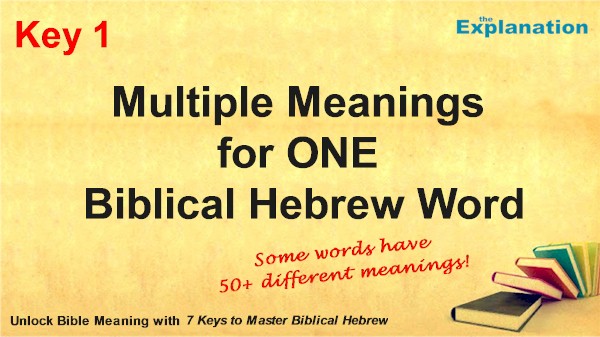
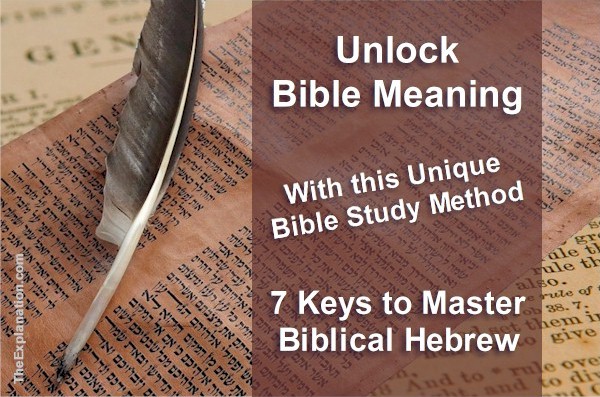
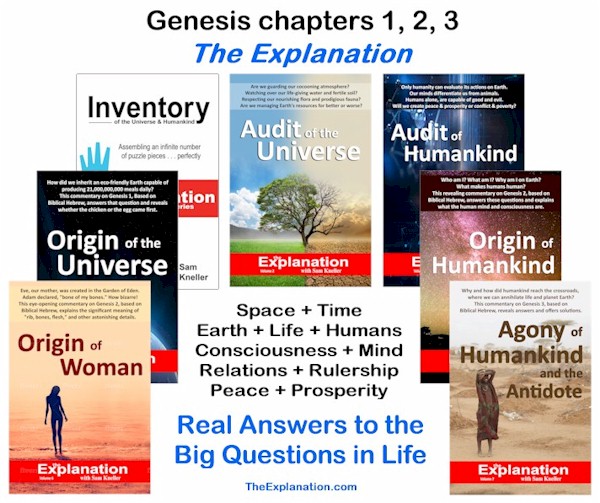
Trackbacks/Pingbacks